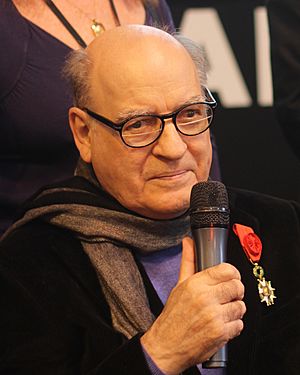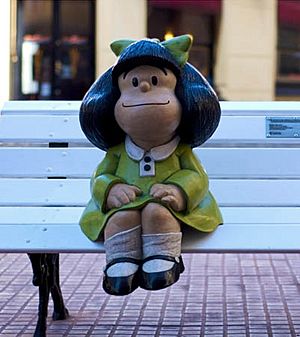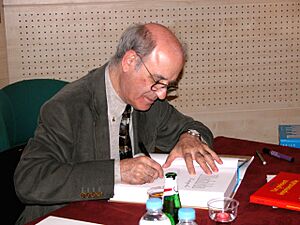Quino facts for kids
Quick facts for kids Quino |
|
|---|---|

Quino in 2014 with the French Legion of Honor
|
|
| Born | Joaquín Salvador Lavado Tejón 17 July 1932 Mendoza, Argentina |
| Died | 30 September 2020 (aged 88) Mendoza, Argentina |
| Area(s) | Cartoonist |
| Pseudonym(s) | Quino |
|
Notable works
|
Mafalda |
| Signature | |
 |
|
Joaquín Salvador Lavado Tejón, known as Quino (born 17 July 1932, died 30 September 2020), was a famous Argentinian cartoonist. He created the popular comic strip Mafalda. This comic strip ran from 1964 to 1973. It was loved in many parts of the Americas and Europe. People praised it for using humor to talk about real-life problems.
Early Life
Joaquín Salvador Lavado Tejón was born in Mendoza, Argentina. His birthday was 17 July 1932. His parents were from Spain. People called him "Quino" from a young age. This helped tell him apart from his uncle, also named Joaquín, who was an illustrator. His uncle helped Quino discover his love for drawing cartoons.
In 1945, Quino started studying art at the Escuela de Bellas Artes de Mendoza. He left his studies a few years later. He wanted to become a cartoonist. Soon after, he sold his first drawing. It was an advertisement for a fabric store.
His first funny drawing page was printed in a magazine called Esto Es. After that, his work appeared in many other magazines. These included Leoplán, TV Guía, and Panorama. By 1954, his cartoons were regularly seen in magazines like Rico Tipo.
Career
Mafalda
Quino's first book of collected drawings, Mundo Quino, came out in 1963. Around the same time, he was making drawings for an advertisement. This was for a company called Mansfield. For this, he created the character of Mafalda. Her name sounded like the company's name. The advertisement was never used. So, Mafalda's first story was printed in Leoplán magazine.
Later, Mafalda appeared regularly in Primera Plana magazine. This was because the magazine's director was Quino's friend. From 1965 to 1967, it was printed in the newspaper El Mundo. Soon, the first Mafalda book was released. It began to be published in Italy, Spain, Portugal, and many other countries. It was also translated into 12 languages.
Mafalda was a smart and curious six-year-old girl. She disliked unfairness and soup, but loved the Beatles. She showed the adult world through the eyes of a clever child. Her friends had different personalities. There was Felipe, who was shy but smart. Susanita loved to gossip. Manolito was strong but not very bright. Miguelito was innocent. Libertad was rebellious and witty. Mafalda also had a baby brother named Guille. Many people compared Mafalda to Charles M. Schulz's Peanuts comic series.
Quino stopped drawing the Mafalda comic strip on 25 June 1973. He said he did not want to repeat himself. Later, he also mentioned that political changes in Latin America affected his choice. He said, "If I had continued drawing her, they would have shot me." After a military takeover in Argentina in 1976, he moved to Milan, Italy. There, he kept creating other funny drawings.
Even though he stopped the comic strip, Quino used Mafalda for special reasons. In 1986, the Spanish government asked him to use her to explain a law about education. In 2020, she appeared in a campaign to raise awareness about COVID-19. In 1977, she helped illustrate the Declaration of the Rights of the Child for UNICEF. An Argentine producer made 260 Mafalda strips into a TV show in 1965.
In 2008, a mural of Mafalda was made in the Perú metro station in Buenos Aires. This was near the Plaza de Mayo. In 2009, Quino showed an original Mafalda drawing. It was part of an exhibition about graphic humor in Buenos Aires.
Later Works
While Mafalda was used for human rights campaigns, Quino focused on other types of comics. These comics were published in Argentina and other countries. Since 1982, the Argentine newspaper Clarín has printed his cartoons every week.
Quino also worked with Cuban cartoon director Juan Padrón. Between 1986 and 1988, they made six short cartoons called Quinoscopio. None of these were longer than six minutes. They also worked on 104 short Mafalda cartoons in 1994. Quino officially retired in 2006.
His later comics showed everyday people and their feelings. The humor was often a bit cynical. It made fun of real-life situations like marriage, technology, and authority. This type of humor helped him become famous in Latin America and other parts of the world. His cartoons have been translated into 26 different languages.
Personal Life
Quino married Alicia Colombo in 1960. They never had children. In 1976, he and his wife moved to Milan, Italy. They returned to Argentina seven years later when the military government ended. After that, he spent his time living in Buenos Aires, Madrid, and Milan. He was an agnostic, meaning he did not believe in God. In 2017, he started to lose his eyesight due to an illness.
Awards and Honors
Quino won many international awards during his career. In 1982, other cartoonists chose him as Cartoonist of the Year. He won the Konex Platinum Award for Visual Arts in 1982 and 1992. He also received special Konex awards in 2012 and 2022. In 1988, he was named an important citizen of Mendoza.
In 2000, he received the Quevedos Ibero-American Prize for Graphic Humor. In March 2014, he was given the French Legion of Honour. A plaza in Buenos Aires was named Plaza Mafalda after his famous character.
In May 2014, the Senate of Argentina gave Quino a cultural award. Later in 2014, Quino received the Prince of Asturias award. This was to honor his work, 50 years after he created Mafalda. He received the award from King Felipe VI of Spain.
An asteroid found in 1999 was named 27178 Quino after him.
Death
Quino passed away on 30 September 2020. He was 88 years old and died from a stroke.
See also
 In Spanish: Quino para niños
In Spanish: Quino para niños



